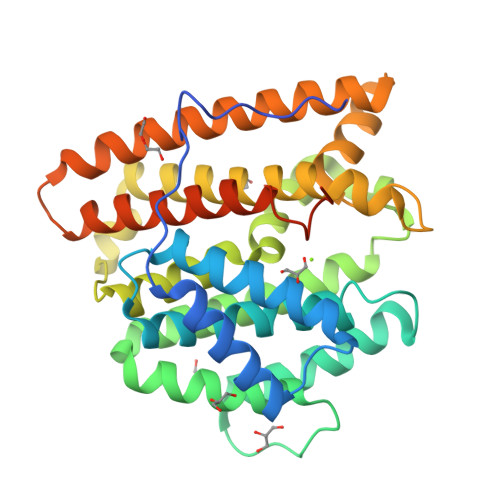The structure of (E)-biformene synthase provides insights into the biosynthesis of bacterial bicyclic labdane-related diterpenoids.
Centeno-Leija, S., Tapia-Cabrera, S., Guzman-Trampe, S., Esquivel, B., Esturau-Escofet, N., Tierrafria, V.H., Rodriguez-Sanoja, R., Zarate-Romero, A., Stojanoff, V., Rudino-Pinera, E., Sanchez, S., Serrano-Posada, H.(2019) J Struct Biol 207: 29-39
- PubMed: 30981884
- DOI: https://doi.org/10.1016/j.jsb.2019.04.010
- Primary Citation of Related Structures:
6OH6, 6OH7, 6OH8 - PubMed Abstract:
The labdane-related diterpenoids (LRDs) are a large group of natural products with a broad range of biological activities. They are synthesized through two consecutive reactions catalyzed by class II and I diterpene synthases (DTSs). The structural complexity of LRDs mainly depends on the catalytic activity of class I DTSs, which catalyze the formation of bicyclic to pentacyclic LRDs, using as a substrate the catalytic product of class II DTSs. To date, the structural and mechanistic details for the biosynthesis of bicyclic LRDs skeletons catalyzed by class I DTSs remain unclear. This work presents the first X-ray crystal structure of an (E)-biformene synthase, LrdC, from the soil bacterium Streptomyces sp. strain K155. LrdC was identified as a part of an LRD cluster of five genes and was found to be a class I DTS that catalyzes the Mg 2+ -dependent synthesis of bicyclic LRD (E)-biformene by the dephosphorylation and rearrangement of normal copalyl pyrophosphate (CPP). Structural analysis of LrdC coupled with docking studies suggests that Phe189 prevents cyclization beyond the bicyclic LRD product through a strong stabilization of the allylic carbocation intermediate, while Tyr317 functions as a general base catalyst to deprotonate the CPP substrate. Structural comparisons of LrdC with homology models of bacterial bicyclic LRD-forming enzymes (CldD, RmnD and SclSS), as well as with the crystallographic structure of bacterial tetracyclic LRD ent-kaurene synthase (BjKS), provide further structural insights into the biosynthesis of bacterial LRD natural products.
Organizational Affiliation:
Consejo Nacional de Ciencia y Tecnología, Laboratorio de Agrobiotecnología, Tecnoparque CLQ, Universidad de Colima, Carretera Los Limones-Loma de Juárez, 28629 Colima, Colima, Mexico. Electronic address: scenteno0@ucol.mx.





















